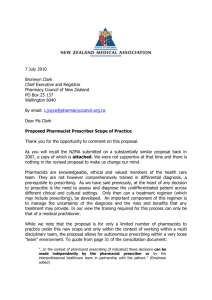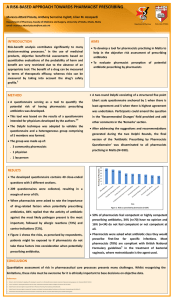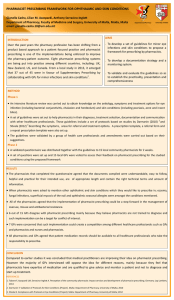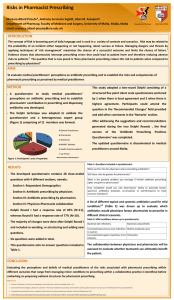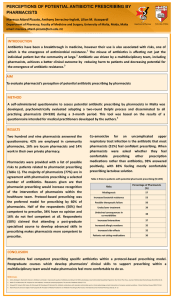Perception of Medical Practitioners on Antibiotic Prescribing by Pharmacists
advertisement
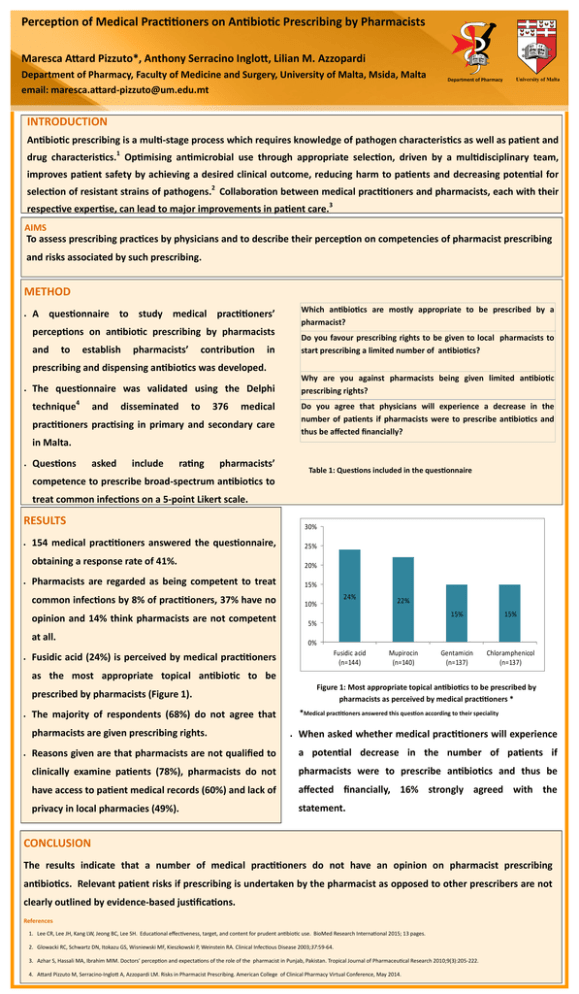
Perception of Medical Practitioners on Antibiotic Prescribing by Pharmacists DEPARTMENT OF PHARM ACY UNIVERSI TY OF MA LTA Maresca Attard Pizzuto*, Anthony Serracino Inglott, Lilian M. Azzopardi Department of Pharmacy, Faculty of Medicine and Surgery, University of Malta, Msida, Malta email: maresca.attard-pizzuto@um.edu.mt Department of Pharmacy University of Malta INTRODUCTION Antibiotic prescribing is a multi-stage process which requires knowledge of pathogen characteristics as well as patient and 1 drug characteristics. Optimising antimicrobial use through appropriate selection, driven by a multidisciplinary team, improves patient safety by achieving a desired clinical outcome, reducing harm to patients and decreasing potential for 2 selection of resistant strains of pathogens. Collaboration between medical practitioners and pharmacists, each with their 3 respective expertise, can lead to major improvements in patient care. AIMS To assess prescribing practices by physicians and to describe their perception on competencies of pharmacist prescribing and risks associated by such prescribing. METHOD Which antibiotics are mostly appropriate to be prescribed by a pharmacist? A questionnaire to study medical practitioners’ perceptions on antibiotic prescribing by pharmacists in Do you favour prescribing rights to be given to local pharmacists to start prescribing a limited number of antibiotics? The questionnaire was validated using the Delphi Why are you against pharmacists being given limited antibiotic prescribing rights? and to establish pharmacists’ contribution prescribing and dispensing antibiotics was developed. technique 4 and disseminated to 376 medical Do you agree that physicians will experience a decrease in the number of patients if pharmacists were to prescribe antibiotics and thus be affected financially? practitioners practising in primary and secondary care in Malta. Questions asked include rating pharmacists’ Table 1: Questions included in the questionnaire competence to prescribe broad-spectrum antibiotics to treat common infections on a 5-point Likert scale. RESULTS 30% 154 medical practitioners answered the questionnaire, 25% obtaining a response rate of 41%. 20% Pharmacists are regarded as being competent to treat 15% common infections by 8% of practitioners, 37% have no 10% opinion and 14% think pharmacists are not competent 22% 15% 15% Gentamicin (n=137) Chloramphenicol (n=137) 5% at all. 24% 0% Fusidic acid (n=144) Fusidic acid (24%) is perceived by medical practitioners Mupirocin (n=140) as the most appropriate topical antibiotic to be Figure 1: Most appropriate topical antibiotics to be prescribed by pharmacists as perceived by medical practitioners * prescribed by pharmacists (Figure 1). pharmacists are given prescribing rights. *Medical practitioners answered this question according to their speciality The majority of respondents (68%) do not agree that When asked whether medical practitioners will experience Reasons given are that pharmacists are not qualified to a potential decrease in the number of patients if clinically examine patients (78%), pharmacists do not pharmacists were to prescribe antibiotics and thus be have access to patient medical records (60%) and lack of affected financially, 16% strongly agreed with the privacy in local pharmacies (49%). statement. CONCLUSION The results indicate that a number of medical practitioners do not have an opinion on pharmacist prescribing antibiotics. Relevant patient risks if prescribing is undertaken by the pharmacist as opposed to other prescribers are not clearly outlined by evidence-based justifications. References 1. Lee CR, Lee JH, Kang LW, Jeong BC, Lee SH. Educational effectiveness, target, and content for prudent antibiotic use. BioMed Research International 2015; 13 pages. 2. Glowacki RC, Schwartz DN, Itokazu GS, Wisniewski MF, Kieszkowski P, Weinstein RA. Clinical Infectious Disease 2003;37:59-64. 3. Azhar S, Hassali MA, Ibrahim MIM. Doctors’ perception and expectations of the role of the pharmacist in Punjab, Pakistan. Tropical Journal of Pharmaceutical Research 2010;9(3):205-222. 4. Attard Pizzuto M, Serracino-Inglott A, Azzopardi LM. Risks in Pharmacist Prescribing. American College of Clinical Pharmacy Virtual Conference, May 2014.
